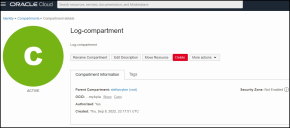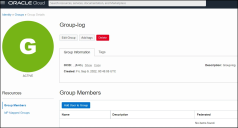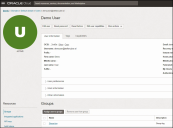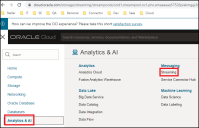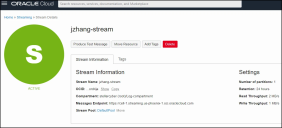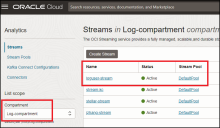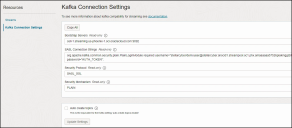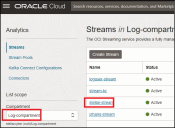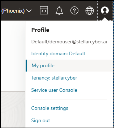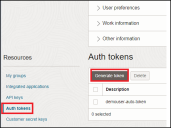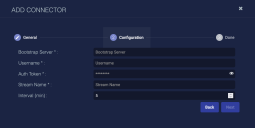Configuring Oracle Cloud Infrastructure (OCI) Connectors
This connector allows Stellar Cyber to ingest logs from the Oracle Cloud Infrastructure (OCI) and add the records to the data lake.
Oracle Cloud Infrastructure integration with Stellar Cyber provides advanced threat detection and response capabilities, combining Oracle's security solutions with real-time threat intelligence and automated response workflows to improve case response and threat mitigation.
This connector queries the Oracle Streaming Service to collect log data found within a provided stream name. The stream can be configured for different log types.
Note the following streaming limits in the Oracle Cloud Infrastructure documentation, Limits on Streaming Resources.
Stellar Cyber connectors with the Collect function (collectors) may skip collecting some data when the ingestion volume is large, which potentially can lead to data loss. This can happen when the processing capacity of the collector is exceeded.
Connector Overview: Oracle Cloud Infrastructure
Capabilities
-
Collect: Yes
-
Respond: No
-
Native Alerts Mapped: Yes

-
Runs on: DP
-
Interval: Configurable
Collected Data
|
Content Type |
Index |
Locating Records |
|---|---|---|
|
Log data in provided Stream Name |
Syslog |
If the OCI log type is com.oraclecloud.vcn.flowlogs.DataEvent, VCN flow log information is reported in the Traffic Index.![]()
Domain
N/A
Response Actions
N/A
Third Party Native Alert Integration Details
This connector ingests logs from OCI to get the raw alerts that are stored in the Syslog index.
Stellar Cyber maps OCI CloudGuard alerts. The alerts are read from the Syslog index, enriched with Stellar Cyber fields, and mapped (with deduplication) to the Alerts index.
Deduplication is by tenantid, oracle.data.additionalDetails.tenantId, event.threat.name, and cloud.resource.id.
The resource types include instances, buckets, and others.
For details, see Integration of Third Party Native Alerts.
Required Credentials
-
Bootstrap Server, Username, Auth Token, and Stream Name
Locating Records
To search the alerts in the Alerts index, use the query: msg_class: oracle_cloud_guard AND exists:event.threat.name
To search the Original Records in the Syslog index, use the query: msg_class: oracle_cloud_guard AND exists:event.threat.name
Let us know if you find the above overview useful.
Adding an Oracle Cloud Infrastructure Connector
To add an Oracle Cloud Infrastructure (OCI) connector:
- Obtain your Oracle Cloud Infrastructure credentials
- Add the connector in Stellar Cyber
- Test the connector
- Verify ingestion
Obtaining your OCI Credentials
Follow the guidance in the Oracle documentation cited in OCI Settings to create the credentials for Stellar Cyber API calls.
OCI Settings
To configure the OCI settings:
-
Log in as an administrative user to the Oracle Cloud console.
-
Skip this step if you have a compartment already. To create a compartment, refer to the Oracle documentation for Adding Users, search for Create a sandbox compartment, and follow the procedure. In this example, the compartment is Log-compartment.
-
To create a user and group, navigate to Domains.
By default, there are two domains in OCI. Select the domain in which you want to create a group and user. In the next step, the example group is created in the Default domain.
-
To create an Oracle Cloud Infrastructure group, refer to the Oracle documentation for Adding Users, search for Create a group, and follow the procedure. In this example, the group is Group-log.
-
To create a user, refer to the Oracle documentation for Adding Users, search for Create a user, and follow the procedure. In this example, the user is demouser@stellarcyber.ai. Then, add the user to the group. In this example, the group is Group-log in the Default domain.
-
Review the Oracle documentation for How Policies Work. In the root compartment, create a policy with the following syntax:
Allow group <identity_domain_name>/<group_name> to <verb> <resource-type> in compartment <compartment_name>
In this example, the group is Group-log in the Default domain and the compartment is Log-compartment:
Allow group default/Group-log to use stream-pull in compartment Log-compartment
In another example, there is a user, loguser@stellarcyber, in the group Group-IDCS-log of the OracleIdentityCloudService, and the compartment is Log-compartment, so the policy will be:
Allow group OracleIdentityCloudService/Group-IDCS-log to use stream-pull in compartment Log-compartment
-
To set up streaming, review the Oracle documentation for Creating a Stream.
-
To create and configure the Oracle Streaming Service, navigate to Analytics & AI and choose Streaming under Messaging.
-
Click Create Stream. Add a Stream Name and select the compartment you created earlier. In this example, the compartment is Log-compartment. If you are creating a stream for the first time, a default Stream Pool, DefaultPool, is created.
-
To create a Service Connector Hub, refer to the Oracle documentation for Creating a service connector.
-
Create the connector under the compartment you created earlier.
Under Configure service connector, note the Source, which is Logging, and the Target, which is Streaming. They will be used to configure the OCI connector with a logging source. Refer to the Oracle Cloud Infrastructure documentation for Creating a Connector with a Logging Source.
-
Navigate to Streams under Analytics and locate the stream's Stream Pool. In this example, the stream name is loguser-stream and the stream pool is the DefaultPool. The compartment is Log-compartment.
-
Navigate to the Kafka Connection Settings in the DefaultPool.
-
Configure the Kafka Connection Settings as follows:
-
The format for Bootstrap Servers is:
cell-1.streaming.<region>.oci.oraclecloud.com:9092. For this example, enter:cell-1.streaming.us-phoenix-1.oci.oraclecloud.com:9092.The Bootstrap Servers is required for the OCI connector configuration.
-
The format for SASL Connection Strings is:
username="<OCI_tenancy_name>/<domain_name>/<your_OCI_username>/<stream_pool_OCID> password="AUTH_TOKEN". For this example, enter:Username:
stellarcyber/Default/StreamUser/ocid1.streampool.oc1.phx.amaaaaaa57526pia6d4ng2pyndugjosjsehmibndthdxxxxxxxxxxxxxxxxxor
Username:
stellarcyber/OracleIdentityCloudService/StreamUser/ocid1.streampool.oc1.phx.amaaaaaa57526pia6d4ng2pyndugjosjxxxxxxxxxThe Username is required for the OCI connector configuration.
-
-
Navigate to Streams and note the stream name.
The Stream Name is required for the OCI connector configuration.
-
To obtain the authentication token, log in using the newly created user, navigate to Profile, and click My profile. In this example, the new user is demouser@stellarcyber.ai.
-
Navigate to Auth tokens and click Generate token, then note the token.
The Auth Token is required for the OCI connector configuration.
Fetching Audit Logs
Once the stream is configured, you need to send audit logs to the configured stream.
Follow the guidance in the Oracle Cloud Infrastructure documentation for Creating a Connector with a Logging Source to transfer log data from the logging service to a target service.
You can also refer to Overview of Audit.
Log Data in the OCI Stream
Stellar Cyber ingests everything sent to the OCI stream. Most of what is ingested is stored in the Syslog index verbatim. The exceptions are:
-
CloudGuard records, which Stellar Cyber normalizes. Stellar Cyber also has an alert integration with OCI CloudGuard, which is described in Integration of Third Party Native Alerts.
-
VCN Flow records which Stellar Cyber normalizes and stores in the Traffic index. These records are identified by the following field:
oracle.type: com.oraclecloud.vcn.flowlogs.DataEvent
Refer to the Oracle documentation: Overview of Streaming or OCI Streaming FAQ.
Adding the Connector in Stellar Cyber
With the access information handy, you can add an OCI connector in Stellar Cyber:
-
Log in to Stellar Cyber.
-
Click System | Integrations | Connectors. The Connector Overview appears.
-
Click Create. The General tab of the Add Connector screen appears. The information on this tab cannot be changed after you add the connector.
The asterisk (*) indicates a required field.
-
Choose PaaS from the Category drop-down.
-
Choose Oracle Cloud Infrastructure from the Type drop-down.
-
For this connector, the supported Function is Collect, which is enabled already.
-
Enter a Name.
Notes:- This field does not accept multibyte characters.
- It is recommended that you follow a naming convention such as tenantname-connectortype.
-
Choose a Tenant Name. This identifies which tenant is allowed to use the connector.
-
Choose the device on which to run the connector.
-
(Optional) When the Function is Collect, you can apply Log Filters. For information, see Managing Log Filters.

-
Click Next. The Configuration tab appears.
The asterisk (*) indicates a required field.
-
Enter the Bootstrap Server you noted above in Obtaining your OCI Credentials.
-
Enter the Username you noted above.
-
Enter the Auth Token you noted above.
-
Enter the Stream Name you noted above.
-
Choose the Interval (min). This is how often the logs are collected.
-
Click Next. The final confirmation tab appears.
-
Click Submit.
The new connector is immediately active.
Testing the Connector
When you add (or edit) a connector, we recommend that you run a test to validate the connectivity parameters you entered. (The test validates only the authentication / connectivity; it does not validate data flow).
For connectors running on a sensor, Stellar Cyber recommends that you allow 30-60 seconds for new or modified configuration details to be propagated to the sensor before performing a test.
-
Click System | Integrations | Connectors. The Connector Overview appears.
-
Locate the connector that you added, or modified, or that you want to test.
-
Click Test at the right side of that row. The test runs immediately.
Note that you may run only one test at a time.
Stellar Cyber conducts a basic connectivity test for the connector and reports a success or failure result. A successful test indicates that you entered all of the connector information correctly.
To aid troubleshooting your connector, the dialog remains open until you explicitly close it by using the X button. If the test fails, you can select the button from the same row to review and correct issues.
The connector status is updated every five (5) minutes. A successful test clears the connector status, but if issues persist, the status reverts to failed after a minute.
Repeat the test as needed.
If the test fails, the common HTTP status error codes are as follows:
| HTTP Error Code | HTTP Standard Error Name | Explanation | Recommendation |
|---|---|---|---|
| 400 | Bad Request | This error occurs when there is an error in the connector configuration. |
Did you configure the connector correctly? |
| 401 | Unauthorized |
This error occurs when an authentication credential is invalid or when a user does not have sufficient privileges to access a specific API. |
Did you enter your credentials correctly? Are your credentials expired? Are your credentials entitled or licensed for that specific resource? |
| 403 | Forbidden | This error occurs when the permission or scope is not correct in a valid credential. |
Did you enter your credentials correctly? Do you have the required role or permissions for that credential? |
| 404 | Not Found | This error occurs when a URL path does not resolve to an entity. | Did you enter your API URL correctly? |
| 429 | Too Many Requests |
This error occurs when the API server receives too much traffic or if a user’s license or entitlement quota is exceeded. |
The server or user license/quota will eventually recover. The connector will periodically retry the query. If this occurs unexpectedly or too often, work with your API provider to investigate the server limits, user licensing, or quotas. |
For a full list of codes, refer to HTTP response status codes.
Verifying Ingestion
To verify ingestion:
- Click Investigate | Threat Hunting. The Interflow Search tab appears.
- Change the Indices to Syslog or for VCN flow logs only, change the Indices to Traffic. The table immediately updates to show ingested Interflow records.
